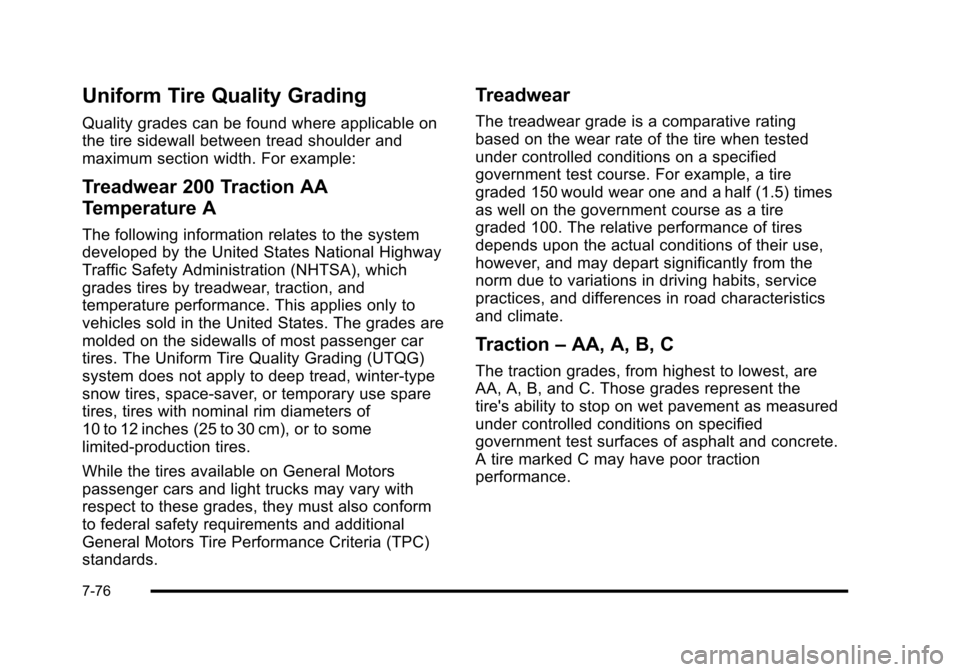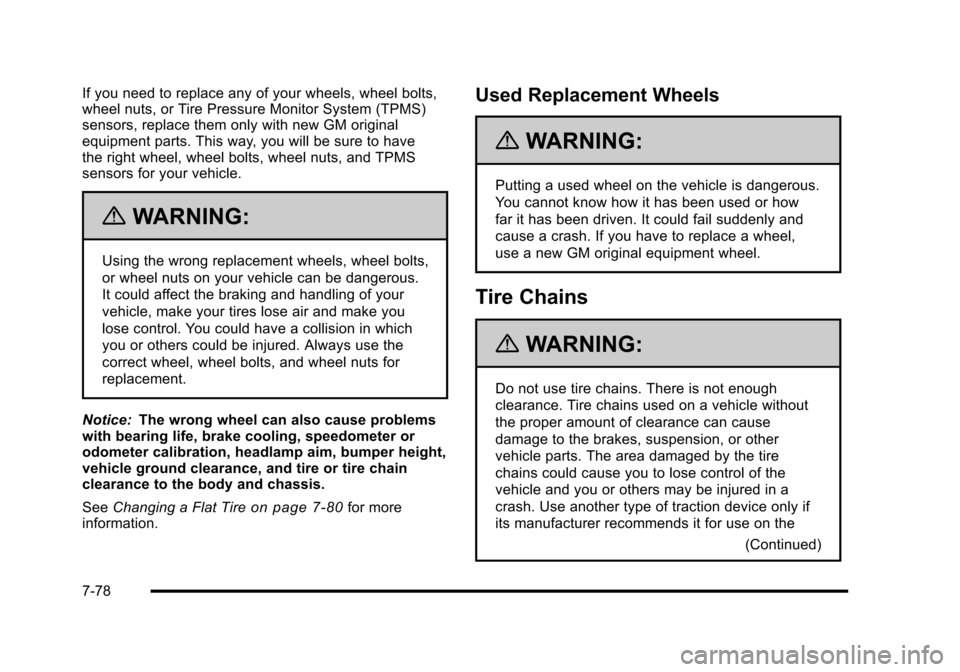traction control CADILLAC ESCALADE 2010 3.G Owner's Manual
[x] Cancel search | Manufacturer: CADILLAC, Model Year: 2010, Model line: ESCALADE, Model: CADILLAC ESCALADE 2010 3.GPages: 616, PDF Size: 39.41 MB
Page 522 of 616

Uniform Tire Quality Grading
Quality grades can be found where applicable on
the tire sidewall between tread shoulder and
maximum section width. For example:
Treadwear 200 Traction AA
Temperature A
The following information relates to the system
developed by the United States National Highway
Traffic Safety Administration (NHTSA), which
grades tires by treadwear, traction, and
temperature performance. This applies only to
vehicles sold in the United States. The grades are
molded on the sidewalls of most passenger car
tires. The Uniform Tire Quality Grading (UTQG)
system does not apply to deep tread, winter-type
snow tires, space-saver, or temporary use spare
tires, tires with nominal rim diameters of
10 to 12 inches (25 to 30 cm), or to some
limited-production tires.
While the tires available on General Motors
passenger cars and light trucks may vary with
respect to these grades, they must also conform
to federal safety requirements and additional
General Motors Tire Performance Criteria (TPC)
standards.
Treadwear
The treadwear grade is a comparative rating
based on the wear rate of the tire when tested
under controlled conditions on a specified
government test course. For example, a tire
graded 150 would wear one and a half (1.5) times
as well on the government course as a tire
graded 100. The relative performance of tires
depends upon the actual conditions of their use,
however, and may depart significantly from the
norm due to variations in driving habits, service
practices, and differences in road characteristics
and climate.
Traction–AA, A, B, C
The traction grades, from highest to lowest, are
AA, A, B, and C. Those grades represent the
tire's ability to stop on wet pavement as measured
under controlled conditions on specified
government test surfaces of asphalt and concrete.
A tire marked C may have poor traction
performance.
7-76
Page 524 of 616

If you need to replace any of your wheels, wheel bolts,wheel nuts, or Tire Pressure Monitor System (TPMS)sensors, replace them only with new GM originalequipment parts. This way, you will be sure to havethe right wheel, wheel bolts, wheel nuts, and TPMSsensors for your vehicle.
{WARNING:
Using the wrong replacement wheels, wheel bolts,
or wheel nuts on your vehicle can be dangerous.
It could affect the braking and handling of your
vehicle, make your tires lose air and make you
lose control. You could have a collision in which
you or others could be injured. Always use the
correct wheel, wheel bolts, and wheel nuts for
replacement.
Notice:The wrong wheel can also cause problemswith bearing life, brake cooling, speedometer orodometer calibration, headlamp aim, bumper height,vehicle ground clearance, and tire or tire chainclearance to the body and chassis.
SeeChanging a Flat Tireon page 7!80for moreinformation.
Used Replacement Wheels
{WARNING:
Putting a used wheel on the vehicle is dangerous.
You cannot know how it has been used or how
far it has been driven. It could fail suddenly and
cause a crash. If you have to replace a wheel,
use a new GM original equipment wheel.
Tire Chains
{WARNING:
Do not use tire chains. There is not enough
clearance. Tire chains used on a vehicle without
the proper amount of clearance can cause
damage to the brakes, suspension, or other
vehicle parts. The area damaged by the tire
chains could cause you to lose control of the
vehicle and you or others may be injured in a
crash. Use another type of traction device only if
its manufacturer recommends it for use on the
(Continued)
7-78
Page 525 of 616

WARNING: (Continued)
vehicle and tire size combination and road
conditions. Follow that manufacturer's
instructions. To help avoid damage to the vehicle,
drive slowly, re!adjust or remove the device if it is
contacting the vehicle, and do not spin the
wheels. If you do find traction devices that will fit,
install them on the rear tires.
If a Tire Goes Flat
It is unusual for a tire to blowout while you are driving,especially if you maintain your vehicle's tires properly.If air goes out of a tire, it is much more likely to leak outslowly. But if you should ever have a blowout, here area few tips about what to expect and what to do:
If a front tire fails, the flat tire creates a drag that pullsthe vehicle toward that side. Take your foot off theaccelerator pedal and grip the steering wheel firmly.Steer to maintain lane position, and then gently braketo a stop well out of the traffic lane.
A rear blowout, particularly on a curve, acts much like askid and may require the same correction you woulduse in a skid. In any rear blowout remove your foot fromthe accelerator pedal. Get the vehicle under control bysteering the way you want the vehicle to go. It may bevery bumpy and noisy, but you can still steer. Gentlybrake to a stop, well off the road if possible.
{WARNING:
Lifting a vehicle and getting under it to do
maintenance or repairs is dangerous without the
appropriate safety equipment and training. If a
jack is provided with the vehicle, it is designed
only for changing a flat tire. If it is used for
anything else, you or others could be badly
injured or killed if the vehicle slips off the jack.
If a jack is provided with the vehicle, only use
it for changing a flat tire.
If a tire goes flat, the next part shows how to use thejacking equipment to change a flat tire safely.
7-79
Page 613 of 616

Tow/Haul Mode . . . . . . . . . . . . . . . . . . . . . . . . . . . . . . . . . . . . 3-36
Tow/Haul Mode Light . . . . . . . . . . . . . . . . . . . . . . . . . . . . . . 4-40
Towing
Recreational Vehicle . . . . . . . . . . . . . . . . . . . . . . . . . . . . . . 6-38
Towing a Trailer . . . . . . . . . . . . . . . . . . . . . . . . . . . . . . . . . . 6-42
Trailer Recommendations . . . . . . . . . . . . . . . . . . . . . . . . 6-55
Your Vehicle . . . . . . . . . . . . . . . . . . . . . . . . . . . . . . . . . . . . . . 6-38
Traction
Magnetic Ride Control . . . . . . . . . . . . . . . . . . . . . . . . . . . . . 6-9
Road Sensing Suspension . . . . . . . . . . . . . . . . . . . . . . . . 6-9
StabiliTrak®System . . . . . . . . . . . . . . . . . . . . . . . . . . . . . . . 6-6
Trailer
Towing Recommendations . . . . . . . . . . . . . . . . . . . . . . . . 6-55
Transmission
Fluid, Automatic . . . . . . . . . . . . . . . . . . . . . . . . . . . . . . . . . . 7-24
Transmission Operation, Automatic . . . . . . . . . . . . . . . . 3-32
Transportation Program, Courtesy . . . . . . . . . . . . . . . . . 9-11
Trip Odometer . . . . . . . . . . . . . . . . . . . . . . . . . . . . . . . . . . . . . 4-29
Turn and Lane-Change Signals . . . . . . . . . . . . . . . . . . . . . .4-5
Turn Signal/Multifunction Lever . . . . . . . . . . . . . . . . . . . . . .4-4
U
Ultrasonic Rear Parking Assist (URPA) . . . . . . . . . . . . 3-46
Uniform Tire Quality Grading . . . . . . . . . . . . . . . . . . . . . . 7-76
Universal Home Remote System . . . . . . . . . . . . . . . . . . 3-55
Operation . . . . . . . . . . . . . . . . . . . . . . . . . . . . . . . . . . . . . . . . . 3-55
V
Vehicle
Control . . . . . . . . . . . . . . . . . . . . . . . . . . . . . . . . . . . . . . . . . . . . 6-3
Loading . . . . . . . . . . . . . . . . . . . . . . . . . . . . . . . . . . . . . . . . . . . 6-32
Remote Start . . . . . . . . . . . . . . . . . . . . . . . . . . . . . . . . . . . . . . 3-7
Running While Parked . . . . . . . . . . . . . . . . . . . . . . . . . . . . 3-42
Symbols . . . . . . . . . . . . . . . . . . . . . . . . . . . . . . . . . . . . . . . . . . . . . iv
Vehicle Customization, DIC . . . . . . . . . . . . . . . . . . . . . . . . 4-57
Vehicle Data Recording and Privacy . . . . . . . . . . . . . . . 9-18
Vehicle Identification
Number (VIN) . . . . . . . . . . . . . . . . . . . . . . . . . . . . . . . . . . . .7-107
Service Parts Identification Label . . . . . . . . . . . . . . . .7-107
Vehicle Positioning . . . . . . . . . . . . . . . . . . . . . . . . . . . . . . . . 5-57
Ventilation Adjustment . . . . . . . . . . . . . . . . . . . . . . . . . . . . . 4-25
Visors . . . . . . . . . . . . . . . . . . . . . . . . . . . . . . . . . . . . . . . . . . . . . 3-21
Voice Recognition . . . . . . . . . . . . . . . . . . . . . . . . . . . . . . . . . 5-86
i - 15